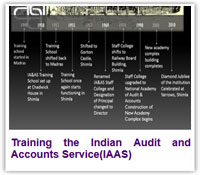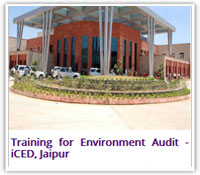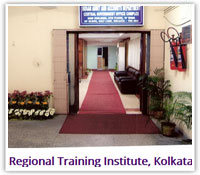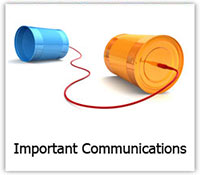Induction Training from Office Trainee’s Perspective
By Mr. Vikas Kumar (2012 batch), Ms. Stefi S and Ms. Priyati Kawdo (2013 batch)
Journey from a civil services aspirant to a successful candidate and further to a responsible officer is very fast and demands a transformation at both intellectual as well as emotional levels. The evolution of an officer during this period would have an everlasting effect on his attitude towards the public, the service and the profession. The enthusiasm of a young recruit needs to be oriented in the right direction and thus, Induction Training Program plays a crucial role.
We came to Yarrows with a bunch of expectations and concerns. A few of us were totally unaware of our future ahead, a few with a slight idea about service (mostly wrong!), a few of us still in examination mode. A few flew directly from the far southern part of the country, trying to cope with the chilling December of “Queen of Hills”; a few from the eastern part trying hard to digest the spicy food and a few from the plains, still gyrating due to motion sickness. With this heterogeneous group, our training started the first week of “ice-breaking” among batch-mates, with the immediate senior batch and other officers in the academy.
The first day team task of Scavenger Hunt not only made us aware of our surroundings of Shimla, but also helped in getting to know other team mates. The training was broadly split into three parts: Phase 1 which is almost a year long comprises of two parts, popularly called Departmental Examinations 1 & 2, and is mostly in the academy, with attachments outside in a few institutions and offices. After Phase 1, we had On-the-Job Training(OJT) of sixteen weeks each with a field audit office and account office. When the OJT was over, we had a Second phase training in the academy for 4 weeks, where final transformation of officer trainees to ‘officers in IAAD’ was carried out to prepare them for the field assignment on posting.
During Phase 1, the academy training consisted of 12 different subjects, which spilled over two Departmental Examinations. The subjects covered included Government Accounts, Principle of Public Sector Accounting, Private Sector Accounting, Principle of Public Sector Auditing, Performance Audit, Compliance Audit, Financial Audit, Public Finance and Introduction to IT systems and IT Audit. Most of these topics were covered by in-house faculty that included the Director General and Directors in the academy. The classes on these topics covered, with a very fine balance, three main aspects: theory and conventional knowledge of the subjects, the current practices in form of first hand experience of the instructors and the international best practices and the future ahead. During training, I feel there is always a tussle between two ideas; whether to train the generation for current practices, so that they can perform their duties well or to prepare them to be a change agent, with a risk of finding them out of place in the field for a while. However, the academy training covered both these aspects.
Training also included many attachments. The first one was related to Public Finance in National Institute of Public Finance & Policy (NIPFP), where we had lectures on concepts of economy and public finance by experts in the fields, whose names were quite familiar to us, as we had read their books or newspaper articles. Other attachments included the ones with SEBI, RBI, NITI Aayog etc. These attachments taught us not only the intricacies of the functioning of these organizations, but also their expectations from the institution of CAG of India.
We also had attachments with field offices of different state government departments like treasuries, forest, Works etc to know their working condition and this also gave us an exposure to various parts of Himachal Pradesh, the people and their life style.Another important attachment outside department was the training program in IIM Ahmedabad. This training for two weeks not only grilled us with different case studies to learn the concepts of finance, but also helped us imbibe the professional values of the corporate world and its interaction with government policies and audit.
Towards end of Phase 1, we had the most interesting part of the training program, i.e. Bharat Darshan cum Study Tour, where we toured the country starting from serene land of Buddhism in Bodhgaya, the womb of learning in Nalanda to the City of Joy, Kolkata. Then we flew to Andaman Island to experience the deep sea flora and fauna. Later we reached the heritage site of Hampi. We also had a visit to Goa, Ahmedabad, Gir, Udaipur and Jaipur. This trip was a journey through all the climatic and cultural variations of the country. During this tour, we visited various field offices, state and central PSUs.
Other than academic and professional training during our stay in Yarrows through classroom lectures, assignments, guest lectures and various visits and attachment, we had many activities to shape our personalities and pursue our hobbies. We had dance classes in the evening, painting classes over weekends, photography workshops etc. All the trainees were formed into various committees like Cultural committee, Sports committee, Photography Committee, Mess committee, literary committee, outdoor activities committee, Social outreach committee, Movies committee. These committees served the purpose of bringing out leaders in everyone, and help all OTs to pursue their interests in a way helpful to others by organizing activities for the whole group.
As a group, officer trainees organized many activities like cultural evening, sports week, Medical camp, photography competition etc. The cultural evening was a hit with individual performances of Bharatnatyam, Kathak, contemporary dances and group performance of a professional play. The evening was surely a delight, and effort put in for the same is a life time memory for each of us.
We also organized the second edition of photography competition cum exhibition Abhivyakti for all the IA&AS officers. The exhibition of the photos on Ridge Road in Shimla was very popular with the local population as well as the tourists. Sports week for the two batches in the academy was a time for interaction and competition with the senior batch. We also ran the crèche in academy for the year of our stay in Yarrows, which was a satisfying experience for everyone.
Between the two Departmental Examinations in Phase 1, we had trekking expedition in the Great Himalayan National Park. For a few days, without any communication and connection with the worlds outside, we were on our trek, supporting each other to complete the trek.
All these activities not only helped us in knowing and bonding with each other, but also made each individual a transformed personality, caring for others, and able to share his feelings, is ready to stand for others and above all, is ready to face any situation. That was the metamorphosis!
During Phase 1, we learnt as a team in the academy and went to different stations for our on-the-job’ training. During OJT, we learnt by doing the task assigned to us in field office by our respective superiors. We had a chance to meet the seniors, listen to their experiences, learnt by seeing them working, assisting them in their work. During OJT, learning with different people in the field was a wonderful experience for all of us. OJT perhaps served as a time for learning before joining the field offices on our posting.
All of us are now posted in different offices throughout the country, looking after different charges with varied set of people. All of us feel that the training was extensive enough to cover all the required areas and interesting enough to ignite us to be ready to always learn.
Continue Reading |
-

From the Editor's Desk
This issue of the journal is the first issue with a thematic approach of “Capacity Building”. It will be our endeavour to continue this approach in future
...more
-

Capacity Building in IA&AD
Mission statement of IA&AD eloquently states “Mandated by the Constitution of India
...more

Training the Indian Audit and Accounts Service(IAAS)
The Officer Trainees (OTs) entering the Indian Audit and Accounts Service(IAAS)
...more
-

Training for Environment Audit - iCED, Jaipur
iCED also contributes to build capacity of other Supreme Audit
...more
|
-

Knowledge Sharing Activities of SAI India
Comptroller and Auditor General of India(SAI India) is acknowledged as a leading
...more
-

Regional Training Institute, Kolkata
In pursuit of excellence
Regional Training Institute, Kolkata was set up in April 1998 as Regional Training Centre.
...more
-

From International Desk
The CAG of India occupies several important positions in INTOSAI and ASOSAI.
...more
-

Important Communications
Amendment to Para 7.12 of PA Guidelines, Compliance Auditing Guidelines, Practitioner's Guide for use of Data Visualisation & Infographics
...more
-

From the Editor's Desk
This issue of the journal is the first issue with a thematic approach of “Capacity Building”. It will be our endeavour to continue this approach in future
...more
|
|
|
|
|